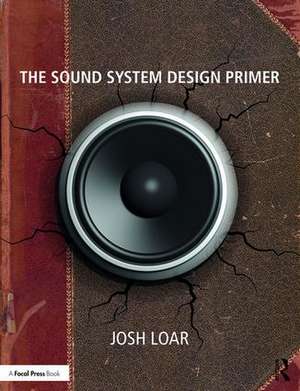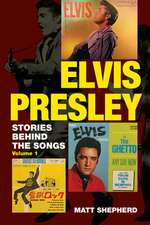The Sound System Design Primer
Autor Josh Loaren Limba Engleză Paperback – 11 mar 2019
Written in clear, conversational language for those who do not have an engineering background, or who think more in language than in numbers, The Sound System Design Primer provides a solid foundation in this expanding discipline for students, early/mid-career system designers, creative and content designers seeking a better grasp on the technical side of things, and non-sound professionals who want or need to be able to speak intelligently with sound system designers.
| Toate formatele și edițiile | Preț | Express |
|---|---|---|
| Paperback (1) | 579.98 lei 3-5 săpt. | |
| Taylor & Francis – 11 mar 2019 | 579.98 lei 3-5 săpt. | |
| Hardback (1) | 854.99 lei 6-8 săpt. | |
| Taylor & Francis – 2 mai 2019 | 854.99 lei 6-8 săpt. |
Preț: 579.98 lei
Preț vechi: 651.66 lei
-11% Nou
Puncte Express: 870
Preț estimativ în valută:
110.99€ • 120.52$ • 93.23£
110.99€ • 120.52$ • 93.23£
Carte disponibilă
Livrare economică 01-15 aprilie
Preluare comenzi: 021 569.72.76
Specificații
ISBN-13: 9781138716889
ISBN-10: 113871688X
Pagini: 610
Ilustrații: 108 Line drawings, color; 163 Halftones, color
Dimensiuni: 210 x 280 x 30 mm
Greutate: 1.64 kg
Ediția:1
Editura: Taylor & Francis
Colecția Routledge
Locul publicării:Oxford, United Kingdom
ISBN-10: 113871688X
Pagini: 610
Ilustrații: 108 Line drawings, color; 163 Halftones, color
Dimensiuni: 210 x 280 x 30 mm
Greutate: 1.64 kg
Ediția:1
Editura: Taylor & Francis
Colecția Routledge
Locul publicării:Oxford, United Kingdom
Public țintă
Professional and Professional Practice & DevelopmentCuprins
Contents
Dedication
List of Figures
Preface: Why This Book? Who Is This Book For?
Acknowledgements
Introduction: What This Book Does, and How It Works
A Note on Safety
Part I: What is a Sound System?
What is a sound system? How does sound itself work? What are the components we need in order to get signal to our audience? Examining the fundamentals of sound, and all the standard components of a contemporary sound system.
Section 1: Basics
Chapter 1: The Four Standard Elements of the Analog Sound System
Chapter 2: The Four Standard Elements of the Digital Sound System
Chapter 3: What Is Sound?—Part 1: Acoustic Version
Chapter 4: What Is Sound?—Part 2: Electric Version
Chapter 5: What Is Sound?—Part 3: Digital Version
Section 2: Inputs
Chapter 6: Microphones (Wired)
Chapter 7: Microphones (Wireless)
Chapter 8: Direct Inputs (Instruments, Turntables, Etc.)
Chapter 9: Playback Devices and Systems
Section 3: Processing
Chapter 10: Preamplifiers and Mixing Consoles
Chapter 11: Effects—Part 1: Creative and Mixing Effects
Chapter 12: D.S.P.: Digital Signal Processing
Chapter 13: Effects—Part 2: System Calibration Effects
Section 4: Amplification
Chapter 14: Power Math
Chapter 15: Power Amplifiers (plus a Note on Power Conditioners,
Uninterruptible Power Supplies, and Distros)
Section 5: Outputs
Chapter 16: Speakers
Chapter 17: Monitoring Systems
Section 6: Computers and Sound
Chapter 18: Networks and Connectivity
Chapter 19: Show Control
Chapter 20: Triggers, Sensors, and Customization
Section 7: Communication Systems
Chapter 21: Audio Com Systems
Chapter 22: Paging Systems
Chapter 23: Video Com—We Know It’s Not Audio, But It’s Almost Always Our Job Anyway!
Section 8: Connections
Chapter 24: Cable Types and Their Uses
Part II: How Do You Set Up, Test, and Calibrate a Basic Sound System?
How do you assemble a sound system? How do you test your gear and troubleshoot problems? Beginning designers often have to do this work themselves, and any designer needs to understand how their system fits together. Examining the installation process.
Section 9: Installation
Chapter 25: Signal Flow, from Installation to Verification
Chapter 26: Testing and Troubleshooting
Section 10: Calibration
Chapter 27: Measurement Tools and Systems
Chapter 28: Measurement Practices, System Calibration and
Optimization
Chapter 29: Acoustic Treatments and Other Solutions
Part III: What Type of Sound System Do You Need?
What are the special questions that need to be asked in each discipline? What are the differences in expected process? What are the schedules and special terms? Examining different sound system types by discipline.
Section 11: The Basic Process of System Design
Chapter 30: Understanding the Source Material
Chapter 31: Understanding the Venue
Chapter 32: Understanding the Audience
Chapter 33: Understanding the Budget and Available Resources
Chapter 34: Selecting Loudspeakers and Positions (Loudspeaker Modeling)
Chapter 35: Selecting the Remaining Equipment and Plan for Operation
Chapter 36: Refining Your Choices
Section 12: The Different Types of Sound System
Chapter 37: Concerts, Small Scale
Chapter 38: Concerts, Large Scale, and Festivals
Chapter 39: Theater—Straight Plays
Chapter 40: Theater—Musicals
Chapter 41: Conventions and Other Multi-Room Live Events
Chapter 42: Performing Arts Venues and Houses of Worship for Permanent Installation
Chapter 43: Supermarkets, Airports, and Other Retail Spaces
Chapter 44: Theme Parks, Cruise Ships, Casinos, and Other Themed Environments
Chapter 45: Recording/Mixing/Mastering Studios (Project and Commercial) for Music, Film, etc. (Including a brief note on Sound Stages for Visual Media)
Chapter 46: Corporate Offices, Hotels, Restaurants, and Other Architectural Environments
Chapter 47: Creative Systems—Multimedia Art Galleries, New Media, New Uses
Part IV: How Do You Document and Present Your Design?
What do you need to do in order to ensure you present your work professionally and effectively? Examining the process, from first meeting to final design documents.
Section 13: Technical Drawing
Chapter 48: Basic Technical Drawing Standards (Organizing and Labeling, Drawing Setup, Notes on Computer Drafting, etc.)
Chapter 49: Plan and Elevation Views (including Rack Elevations)
Chapter 50: System Block Diagrams (Audio, Control, Network Risers)
Chapter 51: Mounting Details
Chapter 52: Magic Sheets
Section 14: Other Technical Documentation
Chapter 53: Hookups and Workbooks
Chapter 54: Equipment (Hardware, Cable, RF, IP, etc.) Schedules and Facilities Impact Reports
Chapter 55: Budget Documents
Chapter 56: Technical Narratives
Chapter 57: Presentation Packaging (to Clients, Bidders, and Integrators)
Section 15: Presenting Your Work to Paying Clients
Chapter 58: First Presentations
Chapter 59: Revisions
Chapter 60: Finalizing and Signing-Off
Afterword: What Comes Next—A Path Forward for The System Designer
Bibliography and Further Reading
Index
Dedication
List of Figures
Preface: Why This Book? Who Is This Book For?
Acknowledgements
Introduction: What This Book Does, and How It Works
A Note on Safety
Part I: What is a Sound System?
What is a sound system? How does sound itself work? What are the components we need in order to get signal to our audience? Examining the fundamentals of sound, and all the standard components of a contemporary sound system.
Section 1: Basics
Chapter 1: The Four Standard Elements of the Analog Sound System
Chapter 2: The Four Standard Elements of the Digital Sound System
Chapter 3: What Is Sound?—Part 1: Acoustic Version
Chapter 4: What Is Sound?—Part 2: Electric Version
Chapter 5: What Is Sound?—Part 3: Digital Version
Section 2: Inputs
Chapter 6: Microphones (Wired)
Chapter 7: Microphones (Wireless)
Chapter 8: Direct Inputs (Instruments, Turntables, Etc.)
Chapter 9: Playback Devices and Systems
Section 3: Processing
Chapter 10: Preamplifiers and Mixing Consoles
Chapter 11: Effects—Part 1: Creative and Mixing Effects
Chapter 12: D.S.P.: Digital Signal Processing
Chapter 13: Effects—Part 2: System Calibration Effects
Section 4: Amplification
Chapter 14: Power Math
Chapter 15: Power Amplifiers (plus a Note on Power Conditioners,
Uninterruptible Power Supplies, and Distros)
Section 5: Outputs
Chapter 16: Speakers
Chapter 17: Monitoring Systems
Section 6: Computers and Sound
Chapter 18: Networks and Connectivity
Chapter 19: Show Control
Chapter 20: Triggers, Sensors, and Customization
Section 7: Communication Systems
Chapter 21: Audio Com Systems
Chapter 22: Paging Systems
Chapter 23: Video Com—We Know It’s Not Audio, But It’s Almost Always Our Job Anyway!
Section 8: Connections
Chapter 24: Cable Types and Their Uses
Part II: How Do You Set Up, Test, and Calibrate a Basic Sound System?
How do you assemble a sound system? How do you test your gear and troubleshoot problems? Beginning designers often have to do this work themselves, and any designer needs to understand how their system fits together. Examining the installation process.
Section 9: Installation
Chapter 25: Signal Flow, from Installation to Verification
Chapter 26: Testing and Troubleshooting
Section 10: Calibration
Chapter 27: Measurement Tools and Systems
Chapter 28: Measurement Practices, System Calibration and
Optimization
Chapter 29: Acoustic Treatments and Other Solutions
Part III: What Type of Sound System Do You Need?
What are the special questions that need to be asked in each discipline? What are the differences in expected process? What are the schedules and special terms? Examining different sound system types by discipline.
Section 11: The Basic Process of System Design
Chapter 30: Understanding the Source Material
Chapter 31: Understanding the Venue
Chapter 32: Understanding the Audience
Chapter 33: Understanding the Budget and Available Resources
Chapter 34: Selecting Loudspeakers and Positions (Loudspeaker Modeling)
Chapter 35: Selecting the Remaining Equipment and Plan for Operation
Chapter 36: Refining Your Choices
Section 12: The Different Types of Sound System
Chapter 37: Concerts, Small Scale
Chapter 38: Concerts, Large Scale, and Festivals
Chapter 39: Theater—Straight Plays
Chapter 40: Theater—Musicals
Chapter 41: Conventions and Other Multi-Room Live Events
Chapter 42: Performing Arts Venues and Houses of Worship for Permanent Installation
Chapter 43: Supermarkets, Airports, and Other Retail Spaces
Chapter 44: Theme Parks, Cruise Ships, Casinos, and Other Themed Environments
Chapter 45: Recording/Mixing/Mastering Studios (Project and Commercial) for Music, Film, etc. (Including a brief note on Sound Stages for Visual Media)
Chapter 46: Corporate Offices, Hotels, Restaurants, and Other Architectural Environments
Chapter 47: Creative Systems—Multimedia Art Galleries, New Media, New Uses
Part IV: How Do You Document and Present Your Design?
What do you need to do in order to ensure you present your work professionally and effectively? Examining the process, from first meeting to final design documents.
Section 13: Technical Drawing
Chapter 48: Basic Technical Drawing Standards (Organizing and Labeling, Drawing Setup, Notes on Computer Drafting, etc.)
Chapter 49: Plan and Elevation Views (including Rack Elevations)
Chapter 50: System Block Diagrams (Audio, Control, Network Risers)
Chapter 51: Mounting Details
Chapter 52: Magic Sheets
Section 14: Other Technical Documentation
Chapter 53: Hookups and Workbooks
Chapter 54: Equipment (Hardware, Cable, RF, IP, etc.) Schedules and Facilities Impact Reports
Chapter 55: Budget Documents
Chapter 56: Technical Narratives
Chapter 57: Presentation Packaging (to Clients, Bidders, and Integrators)
Section 15: Presenting Your Work to Paying Clients
Chapter 58: First Presentations
Chapter 59: Revisions
Chapter 60: Finalizing and Signing-Off
Afterword: What Comes Next—A Path Forward for The System Designer
Bibliography and Further Reading
Index
Recenzii
"[This] book can be enjoyed by newcomers and seasoned pros alike. Whether looking to start a career in audio technology, or brush up on your skills, look no further than The Sound Design Primer." - Brandon Cudequest, Journal of the Audio Engineering Society
Notă biografică
Josh Loar is a sound, lighting, video, and control system designer who has designed projects all over the world, from theaters, to concerts and festivals, to corporate events and conventions, to theme parks. He has worked as a professional designer for more than 20 years. He has designed and engineered systems for clients including Walt Disney Imagineering, Lotte Group, Busch Gardens, and more. He is co-chair and co-author of the upcoming ESET (Essential Skills for Entertainment Technicians) test in audio. He is chair of the USITT (United States Institute for Theatre Technology) Sound Graphics Working Group, working on issuing new and more comprehensive documentation standards for theatrical sound paperwork. He is an accomplished FOH (Front-of-House) and recording engineer, having worked with artists including Paul Simon, David Byrne, Mos Def, Rickie Lee Jones, Charlie Haden, Philip Glass, and many, many more (he has genuinely lost count). He is an educator who has been teaching at the university level for nearly a decade, at Yale School of Drama and now at Michigan Technological University. He is also a multimedia artist, musician, producer, director, and creator of lots of different kinds of weird art. He enjoys long walks in the woods, good whiskey, and the company of intelligent people. Check out his work at www.joshloar.com
Descriere
The Sound System Design Primer is an introduction to the many topics, technologies, and sub-disciplines that make up contemporary sound systems design.


















